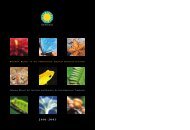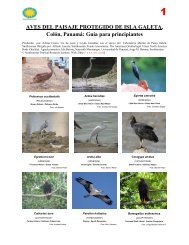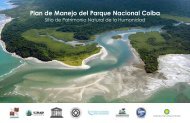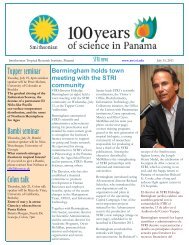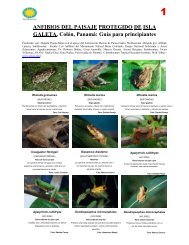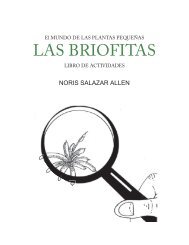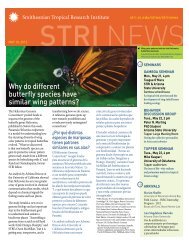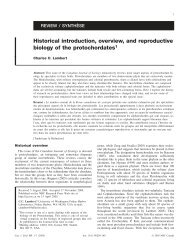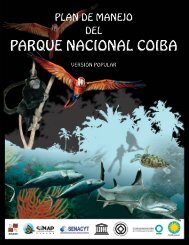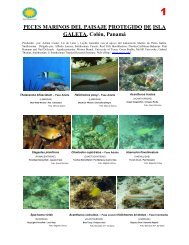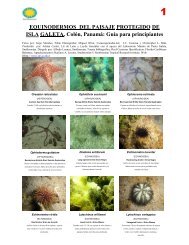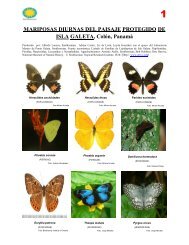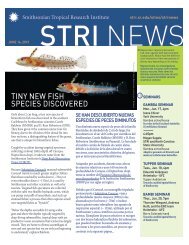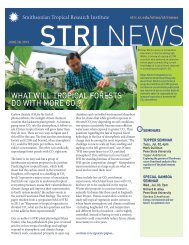does beauty beget weakness? - Smithsonian Tropical Research ...
does beauty beget weakness? - Smithsonian Tropical Research ...
does beauty beget weakness? - Smithsonian Tropical Research ...
Create successful ePaper yourself
Turn your PDF publications into a flip-book with our unique Google optimized e-Paper software.
MARCH 08, 2013<br />
stri.si.edu/sites/strinews<br />
STRI NEWS<br />
Male fiddler crabs use their large<br />
claw in combat to win a mate.<br />
Los cangrejos violinistas machos<br />
utilizan su gran tenaza para ganar<br />
una pareja.<br />
DOES BEAUTY<br />
BEGET WEAKNESS?<br />
Photo by John Christy<br />
SEMINARS<br />
GAMBOA SEMINAR<br />
Tues., Mar. 11, 4:30pm<br />
Fellows Symposium<br />
Practice Talks<br />
Gamboa schoolhouse<br />
Bring your talk for questions<br />
& comments<br />
The longer a male fiddler crab’s big claw the<br />
scarier he is to competitors and the more<br />
attractive to mates. But, like chop sticks, long<br />
claws cannot pinch hard at the tips and long<br />
clawed males may lose fights with males with<br />
shorter, more powerful claws.<br />
This idea is known as the paradox of the<br />
weakening combatant: as a weapon increases in<br />
length, the combatant’s ability to deliver forces<br />
with it in a fight decreases. But do male fiddler<br />
crabs fight with the tips of their claws in chopstick<br />
fight fashion?<br />
STRI scientist John Christy and Stefan<br />
Dennenmoser, STRI intern now at the<br />
University of Calgary, found that male fiddler<br />
crabs don’t usually unleash a crustacean death<br />
grip with their claw tips. Instead, crabs grasp<br />
each other’s claw with the mid-section of their<br />
claws as they attempt to flip the competitor, or<br />
eject him from his burrow, thus winning tussles<br />
for a mate.<br />
The scientists conducted their study around the<br />
Pacific gateway to the Panama Canal, including<br />
at STRI’s Culebra Point. They observed crab<br />
fighting, collected them and measured the<br />
relative position of tubercles—bumps on the<br />
serrated inner claw where the crabs pinch in<br />
a fight.<br />
As claws grow, the tubercles stay close to the<br />
inner part of the claw’s gripping surfaces, which<br />
may compensate for the disadvantage posed by<br />
a longer claw. So claws can be “both beautiful<br />
and powerful weapons,” the researchers write in<br />
the journal Evolution.<br />
¿LA BELLEZA<br />
ENGENDRA DEBILIDAD?<br />
Mientras más grade sea la tenaza del cangrejo<br />
violinista macho, más intimidante es este ante<br />
sus competidores y más atractivo para sus<br />
parejas. Pero, al igual que pasa con los palitos<br />
chinos, las tenazas grandes no pueden apretar<br />
fuertemente con las puntas y los machos con<br />
tenazas grandes pueden perder batallas contra<br />
machos con tenazas más pequeñas y más<br />
poderosas.<br />
Esta idea se conoce como la paradoja del<br />
combatiente débil: a medida que un arma<br />
aumenta en longitud, la capacidad del<br />
combatiente para ejercer fuerza con esta en<br />
una pelea, se reduce. Pero, ¿acaso luchan los<br />
cangrejos violinistas machos con las puntas de<br />
sus tenazas como si fueran peleas con palitos<br />
chinos?<br />
John Christy, científico permanente del<br />
<strong>Smithsonian</strong> en Panamá y Stefan Dennenmoser,<br />
continúa en la siguiente página...<br />
CTFS SEMINAR<br />
Tues., Mar. 12, 10:30pm<br />
Gil Bohrer<br />
Ohio State University<br />
Training Room<br />
From forest to trees – how changes<br />
to tree-level structure affect the<br />
hydrologic, atmospheric and<br />
productivity functions of the forest<br />
TUPPER SEMINAR<br />
Tues., Mar. 12, 4pm<br />
Luis Mejía<br />
STRI<br />
Tupper Auditorium<br />
The genetic and molecular basis<br />
for pathogenic and mutualistic<br />
interactions between a tropical tree<br />
and its associated fungi<br />
BAMBI SEMINAR<br />
Tues., Mar. 14, 7pm<br />
Eric Manzane<br />
University of<br />
Wisconsin-Milwaukee<br />
Barro Colorado Island<br />
Free and support-seeker liana<br />
seedlings: Spatial distribution, life<br />
history and physiological traits in<br />
tropical forests of central Panama
de la página anterior...<br />
pasante del <strong>Smithsonian</strong>, actualmente en la Universidad de Calgary<br />
en Canadá, descubrieron que los cangrejos violinistas machos<br />
usualmente no tiran a atacar con un apretón mortal usando las<br />
puntas de sus tenazas. En cambio, los cangrejos se sujetan unos<br />
a otros de sus tenazas por la sección media de éstas a medida<br />
que intentan voltear a su competidor o sacarlo de su madriguera,<br />
ganando así las luchas por una pareja.<br />
Los científicos llevaron a cabo su estudio cerca de la entrada en<br />
el Pacífico del Canal de Panamá, incluyendo Punta Culebra en la<br />
Calzada de Amador. Observaron la lucha entre los cangrejos, los<br />
recopilaron y midieron la posición relativa de las protuberancias<br />
en el dentado interior de la tenaza, donde los cangrejos aprietan<br />
durante una pelea.<br />
A medida que la tenaza crece, las tuberosidades se mantienen cerca<br />
de la parte interior de la superficie del agarre de la tenaza, lo que<br />
puede compensar la desventaja que representa tener una tenaza<br />
mayor. De manera que las tenazas pueden ser “bellas y poderosas<br />
armas al mismo tiempo” escriben los investigadores en la revista<br />
Evolution.<br />
According to researchers John Christy and Stefan Dennenmoser, male<br />
fiddler crabs’ claws can be “both beautiful and powerful weapons.”<br />
Según los investigadores John Christy y Stefan Dennenmoser, las tenazas<br />
de los cangrejos violinistas machos pueden ser “bellas y poderosas armas<br />
al mismo tiempo”.<br />
Photo by John Christy<br />
FELLOWS AND INTERNS SYMPOSIUM 2013<br />
AGENDA FOR MARCH 15 TH , 2013 | TUPPER AUDITORIUM<br />
9AM | WELCOME BY OWEN MCMILLAN<br />
9:15 | CARLOS DE GRACIA Intern | adv. JARAMILLO<br />
Ancient migration patterns and the fossil fishes from Chagres<br />
Lagerstätte concentration<br />
9:30 | VICTOR FRANKEL Predoc | adv. TORCHIN<br />
Biological invasions drive eco-evolutionary dynamics of emerging<br />
parasites in Panama<br />
9:45 | FERNANDO ALDA Postdoc | adv. BERMINGHAM<br />
Can freshwater fish inform about the age of the Panama Isthmus?<br />
10AM | KATIE CRAMER Postdoc | adv. O’DEA | JACKSON<br />
Changes in Caribbean coral reef environments and fish<br />
communities over the last millennium<br />
10:15 | THOMAS SATTLER Postdoc | adv. PAGE<br />
ChiroPanama: Development of a software-aided bat identification<br />
method and its application in a Panamanian-wide acoustic survey<br />
10:30 | BREAK<br />
10:45 | ALEX TRILLO Postdoc | adv. PAGE<br />
Eavesdroppers and signal evolution: geographic heterogenety in bat<br />
predation and heterospecific transfer of parasitism risk in tropical frogs<br />
11AM | JACOB L. SLUSSER Predoc | adv. HALL<br />
ELTI’s permanent training sites initiative<br />
11:15 | MARTA VARGAS Predoc | adv. MULLER LANDAU<br />
Estimating seed dispersal distances with incomplete genetic data:<br />
new methods, power analyses and a case study of the tropical tree<br />
Tabebuia rosea<br />
11:30 | JESSICA STAPLEY Postdoc | adv. BERMINGHAM<br />
Evolution of a colour-pattern polymorphism in an anolis lizard<br />
11:45 | JUSTIN TOUCHON Postdoc | adv. LESSIOS<br />
Exploring the evolution of reproduction in Dendropsophus<br />
treefrogs<br />
12PM | LUNCH<br />
1:15 | KENDRA WALKER Postdoc | adv. WRIGHT<br />
Forest cover change and land tenure in Panama<br />
1:30 | TEAGUE O’MARA Postdoc | adv. PAGE<br />
Frugivorous bats evaluate the quality of social information when<br />
choosing novel foods<br />
1:45 | LUIS MEJÍA Postdoc | adv. HERRE<br />
Genetic and molecular basis for tropical tree-foliar endophyte<br />
symbioses<br />
2PM | LEONOR ÁLVAREZ Postdoc | adv. SCHNITZER<br />
Liana competition with tropical trees varies with seasonal rainfall<br />
and soil moisture<br />
2:15 | ANDREW SELLERS Intern | adv. TORCHIN<br />
Parasitism in the invasive lionfish Pterois volitans across<br />
latitudinal gradients<br />
2:30 | MICHIEL VAN BREUGEL Postdoc | adv. HALL<br />
Patterns of diversity and composition across the secondary forests of<br />
a dynamic agricultural landscape<br />
2:45 | BREAK<br />
3PM | WOUTER HALFWERK Postdoc | adv. PAGE<br />
Robofrogs & risky ripples: Costs & benefits of multimodal<br />
communication in tungara frogs<br />
3:15 | CATALINA PIMIENTO Predoc | adv. JARAMILLO<br />
Ancient sharks of Panama and Pacific-Caribbean connections<br />
3:30 | GEERTJE VAN DER HEIJDEN Postdoc | adv. SCHNITZER<br />
The impact of lianas on the carbon balance of tropical forests<br />
3:45 | JUAN DAVID CARRILLO Intern | adv. JARAMILLO<br />
The Neotropical fossil record and the Great American biotic<br />
interchange<br />
4PM | CLOSING REMARKS BY ELDREDGE (BIFF) BERMINGHAM,<br />
STRI DIRECTOR<br />
4:30 | POSTER SESSION<br />
5PM | BBQ
This striped hog-nosed skunk was “captured” by a camera trap—an<br />
efficient tool for monitoring forest animals.<br />
Esta gato cañero fue captada por una cámara de captura, una<br />
herramienta eficiente para el monitoreo de animales del bosque.<br />
WHY ARE THERE NO SKUNKS<br />
BETWEEN CONTINENTS?<br />
This photo of a striped hog-nosed skunk, captured on<br />
a mainland peninsula of the Barro Colorado Nature<br />
Monument, is the easternmost record of its species in<br />
Panama. Why there are no hog-nosed skunks reported for<br />
the area from the Panama Canal east to the Colombian<br />
border remains a mystery.<br />
Photo courtesy of Patrick Jansen<br />
¿POR QUÉ NO HAY ZORRILLOS<br />
ENTRE LOS CONTINENTES?<br />
Esta imagen de un zorrillo o gato cañero (Conepatus<br />
semistriatus), captada en una península continental en el<br />
Monumento Natural de Barro Colorado, es el registro de<br />
localización más oriental de esta especie en Panamá. Aún<br />
es un misterio el por qué no se han reportado gatos cañeros<br />
desde el área este del Canal de Panamá hasta la frontera con<br />
Colombia.<br />
Un vistazo a la distribución de este zorrillo (ver mapa),<br />
muestra un área basada en observaciones y colecciones de<br />
museos reportadas en la literatura científica desde México<br />
hasta el oeste de Panamá. Estos zorrillos también han sido<br />
reportados desde el norte de América del Sur y desde un área<br />
alrededor de la desembocadura del Río Amazonas.<br />
¿Por qué esta distribución? “Es difícil saberlo,” comenta<br />
Patrick Jansen, científico permanente del <strong>Smithsonian</strong> en<br />
Panamá y coordinador de esfuerzos de capturas fotográficas<br />
en Panamá, Ecuador, Camerún y Malasia. “Sospecho que<br />
simplemente ningún científico los ha reportado en el este<br />
de Panamá.”<br />
Si ha visto una mofeta bilistada al este del Canal, escriba a:<br />
STRINews@si.edu.<br />
A look at the skunk’s range (see map), shows an area based<br />
on observations and museum collections reported in the<br />
scientific literature from Mexico to western Panama. These<br />
skunks have also been reported from northern South<br />
America and from an area around the mouth of the<br />
Amazon river.<br />
Why this distribution? “Hard to tell,” said Patrick Jansen,<br />
STRI staff scientist and coordinator of camera trapping<br />
efforts in Panama, Ecuador, Cameroon and Malaysia, “I<br />
suspect they have simply not been reported from eastern<br />
Panama by any scientist.”<br />
If you have seen a striped hog-nosed skunk east of the Canal,<br />
send a note to STRINews@si.edu.<br />
SPECIAL SEMINAR<br />
MONDAY<br />
MARCH<br />
25<br />
7PM<br />
David Wardle<br />
Department of Forest Ecology and Management,<br />
Swedish University of Agricultural Sciences, Umeå<br />
Barro Colorado Island<br />
Linkages between vegetation change, consumers and carbon<br />
dynamics: insights from island ecosystems<br />
Sources<br />
Esser, H.J., Liefting, Y., Kays, R., Jansen, P.A. 2012 A record of Striped<br />
Hog-nosed Skunk Conepatus semistriatus in central Panama, between<br />
two known sub-ranges, Small Carnivore Conservation 47, 62-64<br />
Araúz G., J. 2005. La distribución geográfica del zorrillo o gato cañero,<br />
Conepatus semistriatus (Carnivora: Mustelidae) en Panamá. Tecnociencia<br />
(7):87-94.<br />
http://de.wikipedia.org/wiki/Datei:Striped_Hog-nosed_Skunk_area.png
IN A CHANGING<br />
ENVIRONMENT,<br />
SOME SPECIES<br />
FARE BETTER<br />
When corals die, blame is<br />
spread near and far. Pollution<br />
and deforestation join a lineup<br />
of usual suspects that includes<br />
warming waters and more<br />
acidic seas.<br />
Picking apart how local and<br />
global offenders conspire to<br />
wreck reefs is not easy. The<br />
corals that survive may offer<br />
some clues. “Some species<br />
benefit when conditions<br />
change,” says STRI marine<br />
biologist Andrew Altieri. “It’s<br />
an oversimplification to say<br />
everything is getting worse.”<br />
One of Andrews’s primary<br />
research interests is the resilience<br />
of reefs. While coral reefs are<br />
in decline worldwide, relatively<br />
few species have gone extinct.<br />
By moving corals around in<br />
the field and subjecting species<br />
to different conditions in the<br />
laboratory, Andrew will expose<br />
corals to a variety of situations<br />
to understand how they deal<br />
with change.<br />
“Why are some corals found in<br />
one place and not another? Is it<br />
because they failed to arrive or<br />
failed to survive when they got<br />
there?” asks Andrew. He also<br />
questions about the trajectory<br />
of reef decline. “When you see<br />
a major assault on a reef, <strong>does</strong> it<br />
trigger only loss or could there<br />
be a shift? Is it temporary and<br />
will there be a rebound?”<br />
Questions/comments<br />
Preguntas/comentarios<br />
STRINews@si.edu<br />
Photo by Sean Mattson<br />
A ALGUNAS<br />
ESPECIES LES<br />
VA MEJOR EN<br />
UN ENTORNO<br />
CAMBIANTE<br />
Cuando los corales mueren,<br />
la culpa se reparte por todos<br />
lados. La contaminación y la<br />
deforestación se unen a la lista<br />
de los sospechosos habituales en<br />
la que también se encuentran el<br />
calentamiento de aguas y mares<br />
más ácidos.<br />
No es fácil distinguir cómo los<br />
ofensores locales y globales<br />
conspiran en contra de los<br />
arrecifes. Sin embargo, los<br />
corales que sobreviven pueden<br />
ofrecer algunas pistas. “Algunas<br />
especies se benefician cuando las<br />
condiciones cambian,” comenta<br />
Andrew Altieri, científico marino<br />
del <strong>Smithsonian</strong> en Panamá. “El<br />
decir que todo está empeorando<br />
es una simplificación excesiva.”<br />
Uno de los intereses principales<br />
de investigación de Andrew<br />
es la capacidad de resistencia<br />
y/o adaptación de los arrecifes.<br />
Mientras que los arrecifes de<br />
coral alrededor del mundo están<br />
en declive, relativamente pocas<br />
especies se han extinguido. Al<br />
mover corales en el campo de<br />
investigación y someter especies<br />
a distintas condiciones en el<br />
laboratorio, Andrew expondrá<br />
los corales a una variedad de<br />
situaciones para comprender<br />
cómo afrontan el cambio.<br />
“¿Por qué algunos corales<br />
se encuentran en un lugar y<br />
no en otro? ¿Será porque no<br />
lograron llegar a ese lugar o<br />
no lograron sobrevivir cuando<br />
llegaron allí?” se pregunta<br />
Andrew. También cuestiona la<br />
trayectoria del deterioro de los<br />
arrecifes. “Cuando observas una<br />
agresión mayor en un arrecife,<br />
¿sólo desencadena pérdida o<br />
podría haber un cambio? ¿Es<br />
esto temporal y habrá una<br />
recuperación?”
ARRIVALS DEPARTURES PUBLICATIONS<br />
Edmund Tanner<br />
and Chadtip Rodtassana<br />
University of Cambridge<br />
Assessing the importance of litterfall for<br />
tree growth and nutrient dynamics by a<br />
large scale litter removal experiment<br />
Barro Colorado Island<br />
Dina Dechmann<br />
and Martin Wikelski<br />
Max-Planck-Institute for Ornithology<br />
Costs and benefits of sociality in bats -<br />
looking at the example of a tropical species<br />
with a temperate-like social structure<br />
Gamboa<br />
Benjamin Blonder<br />
and Colby Sides<br />
University of Arizona<br />
The kinetics of biodiversity in woody plants<br />
Barro Colorado Island<br />
Erin Datlof<br />
University of Hawaii<br />
Pairing dynamics and the origin of species<br />
Bocas del Toro and Naos Marine Lab<br />
Pedro Acevedo<br />
<strong>Smithsonian</strong> National Museum of<br />
Natural History (SI-NMNH)<br />
Paullinia in Mesoamerica<br />
Barro Colorado Island<br />
Emma Weitzner, Humberto Diaz,<br />
Morgan Linney, Molly Reichert<br />
and Emma Taccardi<br />
Duke University Marine Laboratory<br />
Field Course - Experimental tropical<br />
marine biology /Duke University 2013<br />
Bocas del Toro<br />
Eric Warrant, Emily Baird,<br />
Willi Ribi, Marie Dacke and<br />
Sandra Karlsson<br />
Lund University<br />
Seeing in the dark: Vision and<br />
visual navigation in nocturnal bees<br />
Barro Colorado Island<br />
Timothy Morin<br />
Ohio State University<br />
Do lianas cause chronic disturbance<br />
and alter successional trajectories in<br />
tropical forests?<br />
Barro Colorado Island<br />
Martin How<br />
University of Queensland<br />
Polarisation vision in fiddler crabs<br />
Tupper and Naos Marine Lab<br />
Stanley Heinze<br />
Lund University<br />
Sensory systems of nocturnal<br />
and diurnal bees<br />
Tupper<br />
Stuart Davies<br />
To Panama<br />
To attend the fellowship meeting, meet<br />
with CTFS-SIGEO staff, and STRI Director.<br />
Yves Basset<br />
To Bangkok Thailand<br />
For research, an annual visit to the<br />
SIGEO site of Khao Chong (near Trang),<br />
to supervise his four assistants.<br />
Mary Jane and William Eberhard<br />
To Panama<br />
To attend the fellowship meeting/symposium<br />
and to meet with advisee post doc fellow.<br />
Saskia Santamaria<br />
To Recife Brasil<br />
To attend an ELTI course.<br />
ENTRADA LIBRE<br />
Andersen K. M. and Turner B.<br />
L. 2013. Preferences or plasticity<br />
in nitrogen acquisition by<br />
understorey palms in a tropical<br />
montane forest. Journal of<br />
Ecology DOI: 10.1111/1365-<br />
2745.12070<br />
Condit, R., Engelbrecht, B. M. J.,<br />
Pino, D., Perez, R. and Turner,<br />
B. L. 2013. Species distributions<br />
in response to individual<br />
soil nutrients and seasonal<br />
drought across a community<br />
of tropical trees. Proceedings<br />
of the National Academy<br />
of Sciences,doi:10.1073/<br />
pnas.1218042110<br />
DOCUMENTAL | FORO<br />
Dalling, J. W., Winter, K.,<br />
Andersen, K. M. and Turner,<br />
B. L. 2013. Artefacts of the pot<br />
environment on soil nutrient<br />
availability: implications for<br />
the interpretation of ecological<br />
studies. Plant Ecology, 214:<br />
329-338. doi:10.1007/s112558-<br />
013-0172-3<br />
Turner, B. L. and Blackwell,<br />
M. S. A. 2013. Isolating the<br />
influence of pH on the amounts<br />
and forms of soil organic<br />
phosphorus. European Journal<br />
of Soil Science, doi:10.1111/<br />
ejss.12026<br />
FORO PÚBLICO<br />
EL VALOR DE LA BIODIVERSIDAD<br />
EN AMÉRICA LATINA Y PANAMÁ<br />
14 DE MARZO DE 2013<br />
6-8PM<br />
Auditorio Centro de Conferencias Earl S. Tupper,<br />
Avenida Roosevelt, Corregimiento de Ancón, Ciudad de Panamá<br />
Para más información llamar al<br />
212.8111 | 212.8000 | tejadas@si.edu<br />
La biodiversidad nos envuelve. Es la<br />
característica más extraordinaria de<br />
nuestro planeta. Incluye la riqueza de los<br />
ecosistemas, el número de especies y la<br />
variedad de genes. La biodiversidad es vital<br />
para los humanos en todos los aspectos,<br />
entre ellos, la agricultura, la salud, el turismo<br />
y los servicios ambientales.<br />
Conozca más sobre la biodiversidad de<br />
Panamá y América Latina, en un foro público<br />
en el que la ciencia, el comercio y<br />
la naturaleza se intersecan.<br />
AMÉRICA LATINA Y EL CARIBE:<br />
RIQUEZA VIVA<br />
Documental producido por el Banco Interamericano<br />
de Desarrollo y National Geographic<br />
STANLEY HECKADON<br />
Antropólogo, Sociólogo y Padre de la Conservación en Panamá, STRI<br />
HÉCTOR GUZMÁN<br />
Biólogo Marino y Conservacionista, STRI<br />
ROBERTO IBÁÑEZ<br />
Biólogo, Proyecto de Rescate y Conservación de Anfibios, STRI<br />
JUAN MATÉ<br />
Ecólogo, Programa de Conservación Marino, STRI<br />
ADRIANA SAUTÚ<br />
Bióloga, Coordinadora del Programa Educativo, Biomuseo<br />
HÉCTOR MALARÍN<br />
Jefe de la División de Medio Ambiente y Desarrollo Rural, BID



